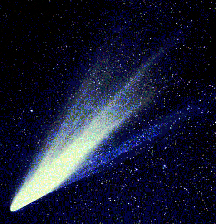Would you like to own a time machine? Of course, right? OK, just to avoid the grandfather paradox, how about a time machine that allowed you to go back in time to watch what happens, not to actually change history? Still cool, huh? But we don’t have time travel technology, do we?
One of the many incredible marvels of our modern life (compared to the lives of our Ancestors) is how much we can know about our history. Today, just by popping in a DVD, we can see many segments of that history, such as the American Revolution, the middle ages, or the building of Stonehenge. For all of these events and so many more, we know many details with decent confidence, based on scientific evidence. Not only do we have details, but for many of them, we even have video portrayals.
 But how can we know where to start? For me, comets can help. While being fascinating in their own right, the appearance of a comet can be a time machine, a reminder to revisit the events in our Ancestry occurring at earlier visits of that same ball of ice and rock. For instance, Halley’s Comet visited us in 1986, and can prompt us to consider what our world was like at earlier visits, such as in 1910, 1835, … 1066, … 141 CE, … 240 BCE, or how our distant grandkids will be doing when it returns in 2061, … 2365, etc. We saw Comet Hale-Bopp in 1997, but it was last here around 2,200 BCE (well before the iron age), and around 6,400 BCE (when many humans were still in the stone age) before that. What will Earth look like when Comet Hale-Bopp returns in about 4,000 years?
But how can we know where to start? For me, comets can help. While being fascinating in their own right, the appearance of a comet can be a time machine, a reminder to revisit the events in our Ancestry occurring at earlier visits of that same ball of ice and rock. For instance, Halley’s Comet visited us in 1986, and can prompt us to consider what our world was like at earlier visits, such as in 1910, 1835, … 1066, … 141 CE, … 240 BCE, or how our distant grandkids will be doing when it returns in 2061, … 2365, etc. We saw Comet Hale-Bopp in 1997, but it was last here around 2,200 BCE (well before the iron age), and around 6,400 BCE (when many humans were still in the stone age) before that. What will Earth look like when Comet Hale-Bopp returns in about 4,000 years?
This year we are lucky to have two comets coming to connect us to our past and our future. The first will be Comet L4, a small comet (not much brighter than most stars), which will be visible in just a few weeks (mid-March), and which returns every 100,000 years or so. When it was last here, our Ancestors got their food by hunting and gathering! Who can guess what our world will be like 100,000, 200,000 and 300,000 years in the future?
The other comet is Comet Nevski, which could be spectacular in December of this year. Comet predicting is notoriously difficult, but Comet Nevski might end up being something to tell the grandkids about, or it could disintegrate. Regardless of its brightness, its orbital period of perhaps 10,000 years brings us back to the dawn of farming.
While we haven’t yet invented a time machine, our knowledge of comets and history can give us a moving substitute for one. It does for me.
Jon Cleland Host